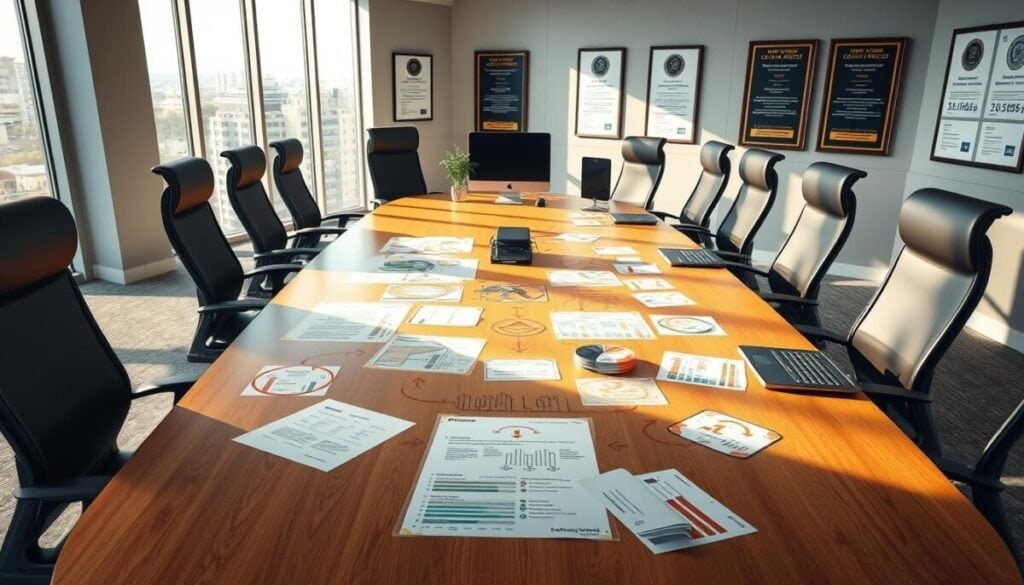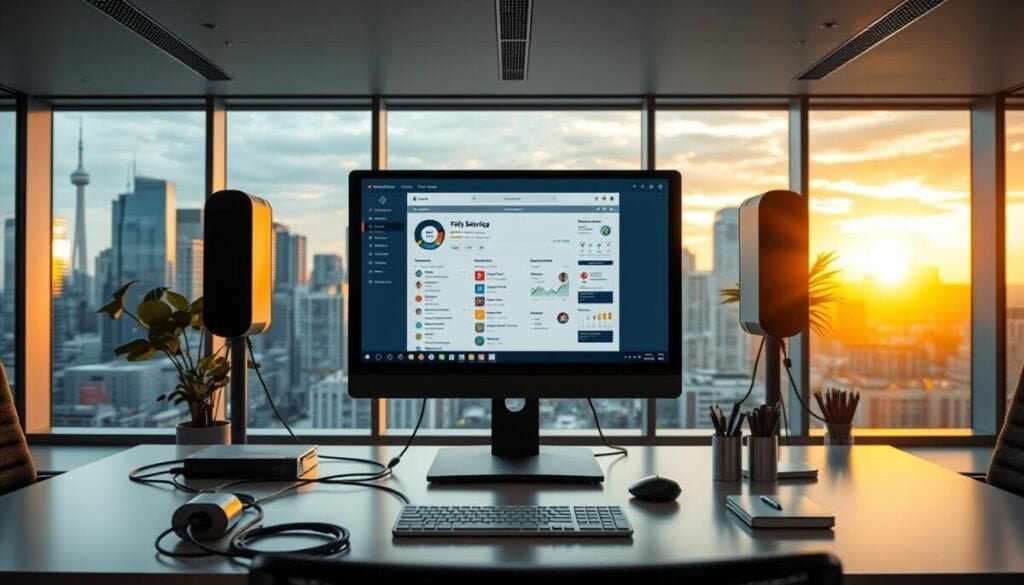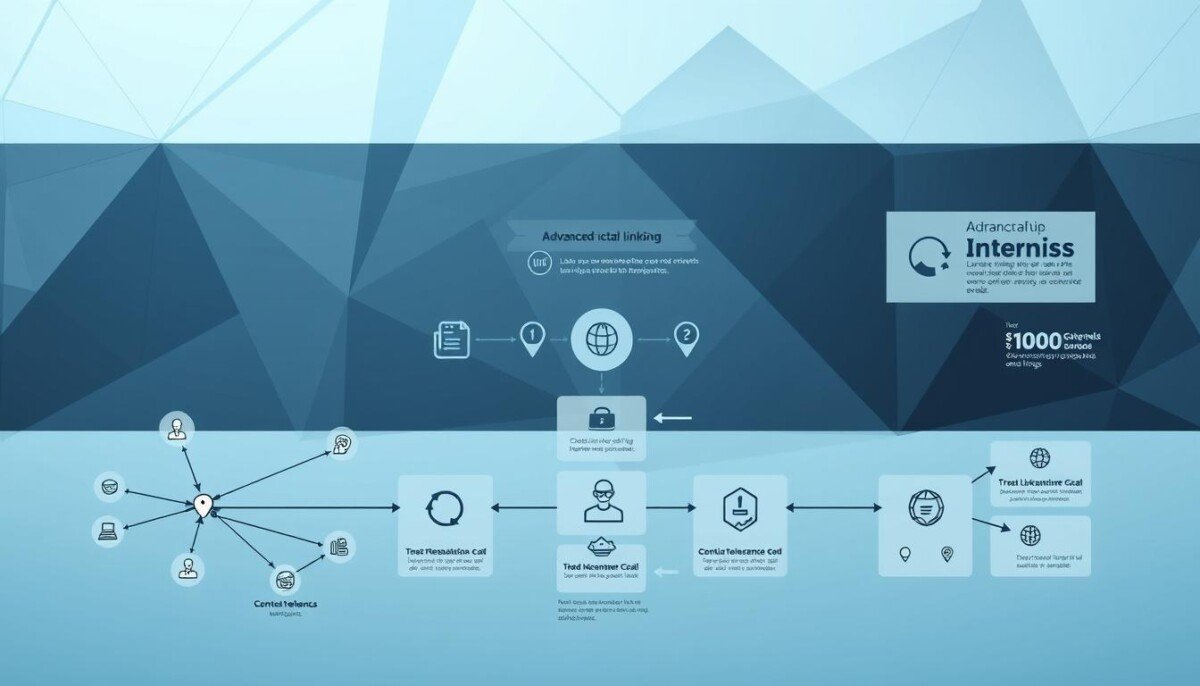Managing a site with thousands of pages can feel overwhelming. How do you ensure every page gets the attention it deserves? For large-scale operations, the answer lies in advanced linking strategies.
Small sites often rely on manual processes, but for extensive platforms, this approach falls short. Poor linking can lead to wasted crawl budgets, equity imbalances, and even lost conversions. These issues can cripple your SEO efforts and harm the user experience.
Automation is no longer optional—it’s essential. By implementing advanced techniques, you can streamline your site’s structure, improve visibility, and boost performance. Let’s explore how these strategies can transform your approach.
Key Takeaways
- Effective linking is critical for large-scale sites.
- Manual processes are inefficient for managing thousands of pages.
- Poor linking can waste crawl budgets and harm SEO.
- Automation is key to maintaining site structure and equity.
- Advanced techniques improve visibility and user experience.
Why Enterprise Internal Linking Matters for SEO
The backbone of any successful website lies in its ability to guide users and search crawlers effectively. Internal links act as the circulatory system of a site, ensuring that every page is accessible and valuable. Without a solid linking strategy, even the best content can get lost in the shuffle.
The Role of Internal Links in Site Structure
Search engines rely on internal links to discover and index pages. These links help distribute link equity, ensuring that important pages receive the attention they deserve. Think of it like Venice’s bridges—each connection makes it easier to navigate and explore.
Using the 3-click rule, we can ensure that users and crawlers can access any page within three clicks. This approach not only improves search visibility but also enhances the overall structure of the site.
How Internal Linking Enhances User Experience
Beyond SEO, internal links play a crucial role in improving user experience. Contextual links guide visitors to related content, reducing navigation time and keeping them engaged. This seamless flow encourages users to explore more, boosting both satisfaction and conversions.
By strategically placing links, we can create a clear path for users, ensuring they find what they need quickly and efficiently. This not only enhances their experience but also strengthens the site’s topical authority.
Challenges of Internal Linking in Enterprise SEO
Handling large-scale websites requires precision and strategy. When dealing with thousands of pages, even minor oversights can lead to significant issues. These challenges often stem from inefficient links, uneven link equity distribution, and the risk of creating content silos.
Managing Thousands of URLs
For sites with millions of pages, keeping track of every URL is a daunting task. Studies show that large platforms experience a 15% annual orphan rate, leaving valuable content unlinked and inaccessible. Tools like Oncrawl and Ahrefs help visualize the link graph, making it easier to identify gaps.
Link Equity Distribution and Crawl Budget
Ensuring fair link equity distribution is crucial. Overlinking to hub pages can create bottlenecks, while underlinked content loses visibility. For a site with 10 million pages, a 3-month refresh cycle is essential to optimize the crawl budget. This ensures crawlers efficiently index the site.
Preventing Content Silos and Orphaned Pages
Content silos can reduce cross-conversion rates by up to 37%. By conducting regular audits with tools like SE Ranking, we can identify and fix orphaned pages. This not only improves SEO but also enhances the overall user experience.
| Challenge | Impact | Solution |
|---|---|---|
| Orphaned Pages | 15% annual orphan rate | Regular audits with SE Ranking |
| Crawl Budget | 10M pages needing 3-month cycles | Optimize link equity distribution |
| Content Silos | 37% lower cross-conversion rates | Link graph visualization tools |
Foundations of a Strong Internal Linking Strategy
Building a robust linking strategy starts with understanding your site’s structure. A well-organized approach ensures every page is accessible and valuable. Without a clear roadmap, even the best content can get lost in the shuffle.
Understanding Your Site’s Link Graph
Your site’s link graph is the foundation of your strategy. It maps how pages connect and how authority flows. Key metrics like inlink/outlink ratios, click depth, and authority flow help identify gaps and opportunities.
Tools like SE Ranking can visualize this graph, making it easier to spot underlinked content. Regular analysis ensures your site remains efficient and optimized for SEO.
Identifying High-Value Pages
Not all pages are created equal. High-value content drives traffic and conversions. Use criteria like commercial potential, traffic capacity, seasonality, and business goals to prioritize these pages.
For example, product pages often have high commercial potential. By focusing on these, you can maximize your site’s impact and improve overall performance.
Setting Internal Linking Goals
Clear goals guide your strategy. SMART objectives, like increasing product page equity by 25% in Q3, provide measurable targets. PageRank sculpting techniques can help distribute authority effectively.
Content gap analysis using keyword grouping ensures your links align with user intent. This approach strengthens your site’s topical authority and improves visibility.
| Key Step | Action | Outcome |
|---|---|---|
| Link Graph Analysis | Map inlink/outlink ratios | Identify gaps and opportunities |
| High-Value Pages | Prioritize based on criteria | Maximize traffic and conversions |
| Linking Goals | Set SMART objectives | Improve equity distribution |
By focusing on these foundations, you can create a strategy that enhances your site’s structure, improves SEO, and drives results.
Advanced Techniques for Scalable Internal Linking

Scaling internal linking strategies for large websites demands innovative solutions. As sites grow, manual processes become inefficient, and advanced tools are essential to maintain structure and performance. By leveraging automation, pillar pages, and optimized anchor text, we can ensure every page is connected and valuable.
Automating Internal Links with AI and NLP Tools
Automation is a game-changer for managing large-scale websites. Tools like Clearscope, MarketMuse, and INK use AI and NLP to analyze content and suggest relevant links. For example, Cisco implemented API automation, achieving a 58% faster linking process. Python scripts can also integrate NLP into WordPress, streamlining link creation and improving efficiency.
Building Pillar Pages and Topic Clusters
Pillar pages and topic clusters organize content into silos, enhancing both SEO and user experience. A pillar page acts as a hub, linking to related subtopics. This structure helps search engines understand the site’s hierarchy and improves topical authority. Using a content silo template, we can develop clusters that guide users and crawlers effectively.
Optimizing Anchor Text for Relevance and SEO
Anchor text plays a crucial role in linking strategies. A balanced approach includes 60% partial-match, 20% exact-match, and 20% branded anchors. This mix ensures relevance while avoiding over-optimization. Optimized anchor text can lead to a 41% faster indexation rate, improving overall SEO performance.
| Anchor Text Type | Percentage | Purpose |
|---|---|---|
| Partial-Match | 60% | Enhances relevance without over-optimization |
| Exact-Match | 20% | Targets specific keywords |
| Branded | 20% | Strengthens brand recognition |
By implementing these advanced techniques, we can create a scalable linking strategy that improves site structure, enhances SEO, and delivers a better user experience.
Tools for Diagnosing and Improving Internal Linking
Effective site management relies on the right tools to diagnose and improve connections. For large sites, manual processes are inefficient, and advanced solutions are essential. By leveraging specialized tools, we can identify gaps, optimize links, and enhance overall performance.
Using Crawlers for Technical Audits
Crawlers like Screaming Frog and SiteBulb are indispensable for technical audits. Screaming Frog excels in analyzing smaller sites, while SiteBulb is better suited for larger platforms. These tools help identify broken links, orphaned pages, and crawl errors.
For example, IBM optimized its crawl budget by 83% using Botify. This case study highlights the importance of selecting the right crawler for your site’s needs.
Analyzing Link Equity Flow with SEO Platforms
Understanding how link equity flows is crucial for site optimization. Platforms like Ahrefs’ Site Explorer provide detailed analysis of inlinks and outlinks. This helps ensure that high-value pages receive the attention they deserve.
SE Ranking’s orphan page detection process is another valuable feature. It identifies unlinked pages, ensuring no content is left behind.
Monitoring Crawl Efficiency with Log File Analysis
Log file analysis offers insights into how search engines interact with your site. Tools like Splunk segment data to highlight crawl patterns and inefficiencies. Monitoring key metrics, such as crawl depth and frequency, ensures optimal use of your crawl budget.
By implementing these techniques, we can improve traffic, enhance SEO, and create a more efficient site structure.
Best Practices for Enterprise Internal Linking

A well-structured approach to connecting pages ensures seamless navigation and better performance. For large-scale websites, adopting proven best practices is essential to maintain efficiency and improve user experience. Let’s explore how to create a robust framework for your team.
Creating a Linking Playbook for Teams
Developing a strategy starts with a clear playbook. A well-defined guide ensures consistency across all pages. For example, setting a minimum of three links per post can enhance connectivity. Microsoft’s “Content Bridge” program demonstrates how cross-silo training fosters collaboration and improves linking adoption by 29%.
Training Teams to Think Cross-Silo
Encouraging teams to think beyond their immediate tasks is crucial. Cross-silo training helps identify opportunities to connect related content. This approach not only strengthens site structure but also boosts user experience by guiding visitors to relevant information.
Baking Link QA into Publishing Workflows
Integrating quality assurance into publishing workflows ensures accuracy. A 5-step audit process, including pre-publish checks with tools like Screaming Frog, can identify issues early. Jira integration for automated link validation further streamlines the process, reducing errors and improving efficiency.
By implementing these best practices, we can create a cohesive linking framework that enhances site performance and delivers a better experience for users.
Optimizing Crawl Budget with Internal Links
Maximizing crawl efficiency is essential for large websites to ensure every page gets indexed and performs well. A well-structured approach to connecting pages can significantly improve how crawlers interact with your site. By focusing on reducing link depth, surfacing orphaned content, and consolidating thin pages, we can create a more efficient strategy.
Reducing Link Depth for Key Pages
Deep link structures can hinder crawlers from accessing important pages. Implementing the 3-click rule ensures that users and bots can reach any page within three clicks. Breadcrumb optimization is a practical technique to reduce link depth. For example, Walmart’s 12M page cleanup project achieved a 57% boost in indexation by simplifying navigation.
Surfacing Orphaned and Underlinked Content
Orphaned pages often go unnoticed, wasting valuable content. Dynamic related content modules can help resurface these pages by automatically suggesting relevant links. Regular audits using tools like Screaming Frog or Ahrefs can identify gaps and ensure no page is left behind.
Consolidating Thin and Duplicative Pages
Thin or duplicate pages can dilute your site’s authority and waste crawl budget. Consolidating these into comprehensive content hubs improves SEO and user experience. Verizon’s case study showed a 57% increase in indexation after consolidating thin pages. Additionally, comparing pagination vs. infinite scroll can help optimize crawl efficiency.
By addressing these areas, we can create a more efficient crawl budget, improve traffic, and enhance overall site performance.
Enhancing User Experience Through Internal Linking

Creating a seamless journey for users is at the heart of every successful website. By strategically connecting pages, we can guide visitors to the content they need while improving overall navigation. This approach not only boosts user experience but also drives meaningful conversions.
Guiding Users with Contextual Links
Contextual links are essential for keeping users engaged. These links appear naturally within content, guiding visitors to related topics. For example, HubSpot saw a 22% increase in session duration by optimizing contextual links.
Heatmap analysis shows that contextual links have a 35% higher click-through rate (CTR) compared to navigational links. This highlights their effectiveness in improving user experience.
Improving Navigation with Breadcrumbs and Sidebars
Breadcrumbs and sidebars simplify navigation, helping users find their way back or explore related content. Best practices include placing breadcrumbs at the top of the page and using sidebars for quick access to key pages.
Zappos implemented breadcrumb optimization, resulting in a $3M revenue lift from improved product linking. This demonstrates the tangible benefits of enhancing navigation.
Driving Conversions with Strategic Links
Strategic links guide users toward conversion goals. For SaaS sites, mapping conversion paths ensures visitors move seamlessly from awareness to purchase. Mobile-first linking considerations are also crucial, as 60% of users access content via mobile devices.
By focusing on conversion-oriented links, we can create a more effective user journey. This approach not only improves SEO but also maximizes the impact of every page.
| Strategy | Impact | Example |
|---|---|---|
| Contextual Links | 35% higher CTR | HubSpot’s session duration increase |
| Breadcrumbs | $3M revenue lift | Zappos’ product linking success |
| Conversion Paths | Improved user journey | SaaS site optimization |
Operationalizing Internal Linking at Scale
Scaling a website’s connectivity requires a systematic approach to ensure every piece of content is accessible and valuable. For large websites, manual processes are inefficient, and advanced tools and automation are essential. By integrating linking logic into CMS systems, automating updates, and coordinating efforts across teams, we can create a seamless and scalable strategy.
Building Linking Logic into CMS Components
Integrating linking logic into your CMS ensures consistency and efficiency. Headless CMS platforms like Contentful and Strapi allow for dynamic linking architectures. For example, Salesforce achieved a 74% efficiency gain by embedding linking rules directly into their CMS workflows.
Using Python scripts, we can automate bulk link injection, ensuring every new page is connected to relevant content. This approach not only saves time but also reduces the risk of orphaned pages.
Automating Retroactive Linking Updates
Updating links across thousands of pages manually is impractical. Automation tools like SE Ranking can scan your site and suggest retroactive updates. Version control protocols ensure that changes are tracked and implemented without errors.
For global enterprises, multilingual linking matrices help maintain consistency across regions. This ensures that localized content remains connected to the broader site structure.
Coordinating Linking Across Teams and Regions
Collaboration is key to successful linking at scale. Workflow templates in tools like Asana and ClickUp streamline coordination across teams. Cross-regional training ensures that all contributors understand the linking strategy and its importance.
By fostering a culture of collaboration, we can ensure that every page is optimized for both SEO and user experience.
Measuring the Impact of Internal Linking

Understanding the effectiveness of your site’s connections is crucial for long-term success. By tracking key metrics, we can identify strengths, address weaknesses, and optimize performance. This process ensures that every page contributes to your site’s goals.
Tracking Crawl Efficiency and Indexation
Monitoring how search engines interact with your site is essential. Tools like Google Search Console provide insights into indexation rates and crawl errors. For example, Adobe improved its SERP visibility by 39% by optimizing crawl efficiency.
Key indicators include crawl depth, frequency, and orphaned pages. Regular audits help ensure that all pages are accessible and indexed properly.
Analyzing Traffic and Conversion Metrics
Connections directly influence user behavior and outcomes. By analyzing traffic patterns, we can identify which pages drive the most visits. Attribution modeling helps trace conversion paths, revealing how links contribute to sales or leads.
For instance, optimizing contextual links can increase session duration by 22%. This highlights the importance of strategic placement.
Monitoring Link Equity Distribution
Ensuring fair distribution of authority is critical for SEO. Tools like CognitiveSEO and LinkResearchTools track how equity flows across your site. This helps identify underlinked pages and bottlenecks.
Quarterly reports provide a clear picture of your site’s health. By addressing gaps, we can improve overall performance and user experience.
| KPI | Purpose | Tool |
|---|---|---|
| Crawl Efficiency | Optimize indexation | Google Search Console |
| Traffic Patterns | Identify high-performing pages | Google Analytics |
| Link Equity Flow | Ensure fair distribution | CognitiveSEO |
By focusing on these areas, we can create a data-driven strategy that enhances your site’s performance and drives meaningful results.
Common Pitfalls in Enterprise Internal Linking
Even the best strategies can falter if common pitfalls aren’t addressed. For large websites, small oversights in connectivity can lead to significant setbacks. Let’s explore the most frequent mistakes and how to avoid them.
Overlinking Top Pages
Overlinking to high-value pages can create bottlenecks in your site’s structure. A case study revealed that excessive links to top pages caused an 18% drop in rankings. This happens because search engines perceive it as an attempt to manipulate SEO.
To prevent this, balance your links across all pages. Use tools like Ahrefs to monitor link distribution and ensure equity flows evenly. This approach maintains user experience while improving overall performance.
Ignoring Orphaned Content
Orphaned content is a hidden problem that can waste valuable resources. Statistics show that 15% of pages on large sites become orphaned annually. These unlinked pages are invisible to both users and search engines.
Implement a recovery framework to resurface orphaned content. Dynamic related content modules and regular audits can help identify and fix these gaps. This ensures every page contributes to your site’s success.
Failing to Update Legacy Links
Legacy links often go unnoticed, leading to technical debt. A Fortune 500 firm reported $2.3M in annual costs due to outdated links. Broken or irrelevant links harm both SEO and user experience.
Automate broken link detection workflows to streamline updates. A 5-step legacy update protocol ensures that all links remain relevant and functional. This proactive approach saves time and resources while maintaining site integrity.
By addressing these common pitfalls, we can create a more effective strategy that enhances site performance and delivers a better experience for users.
Future-Proofing Your Internal Linking Strategy
To stay ahead in the ever-evolving digital landscape, your site’s connectivity must adapt to future trends. As search algorithms and user behaviors change, a forward-thinking strategy ensures your pages remain relevant and accessible. Let’s explore how to future-proof your approach to linking.
Adapting to Algorithm Changes
Search engines constantly update their algorithms, impacting how links are evaluated. Staying informed about these changes is crucial. For example, Google’s BERT update emphasized natural language processing, making contextual links more important than ever.
Tools like MarketMuse use AI to predict algorithm shifts, helping you adjust your strategy proactively. By focusing on relevance and quality, you can maintain strong SEO performance despite algorithm updates.
Scaling for Global Content Operations
Managing content across multiple regions requires a scalable approach. Multilingual linking matrices ensure consistency while catering to local audiences. For instance, a global e-commerce site might use region-specific pages to improve user experience.
Headless CMS platforms like Contentful enable dynamic linking architectures, making it easier to manage large-scale operations. This ensures every page is connected, regardless of language or region.
Integrating Internal Linking with Emerging Technologies
Emerging technologies like AI, blockchain, and IoT are reshaping how we approach linking. AI-powered tools can predict optimal anchor text, while blockchain ensures links remain secure and verifiable.
Voice search optimization is another critical area. As more users rely on voice assistants, optimizing links for natural language queries becomes essential. Accenture’s IoT linking framework demonstrates how integrating technology can enhance site connectivity.
- AI/ML trends: Predictive anchor text and dynamic linking suggestions.
- Multilingual matrices: Ensure consistency across global pages.
- Blockchain verification: Prototype for secure and verifiable links.
- Voice search optimization: Adapt links for natural language queries.
- IoT framework: Case study on Accenture’s innovative approach.
By embracing these advancements, you can create a robust strategy that adapts to future challenges and opportunities. This ensures your site remains competitive and user-friendly in the long term.
Taking Your Enterprise Internal Linking to the Next Level
Elevating your site’s connectivity requires a blend of strategy and innovation. By focusing on seven core principles—such as optimizing anchor text and building pillar pages—you can create a robust framework for success. To assess your progress, use our maturity model tool to identify gaps and opportunities.
Start with a 90-day implementation plan. Prioritize high-value pages, automate updates, and conduct regular audits. Tools like Screaming Frog and Ahrefs can streamline this process, ensuring every link contributes to your site’s performance.
Looking ahead, innovations like AI-driven linking and voice search optimization will shape the future of SEO. Stay adaptable and embrace these advancements to keep your site competitive. Just like Venice’s bridges, every connection you build strengthens the overall structure and experience.
Ready to take the next step? Audit your site today and uncover hidden potential. Your journey to seamless connectivity starts now.



